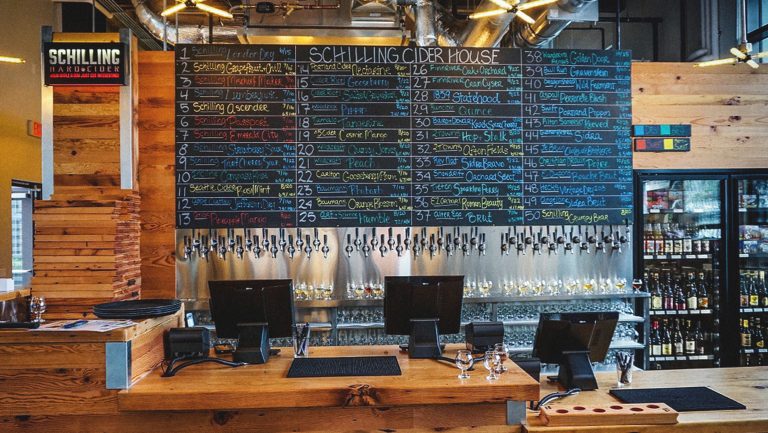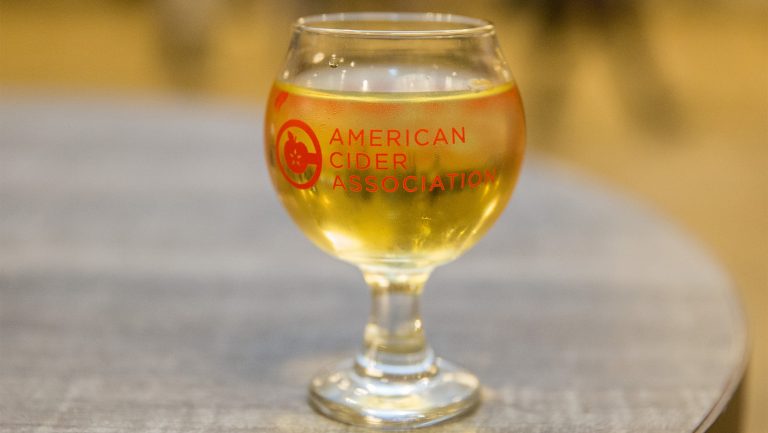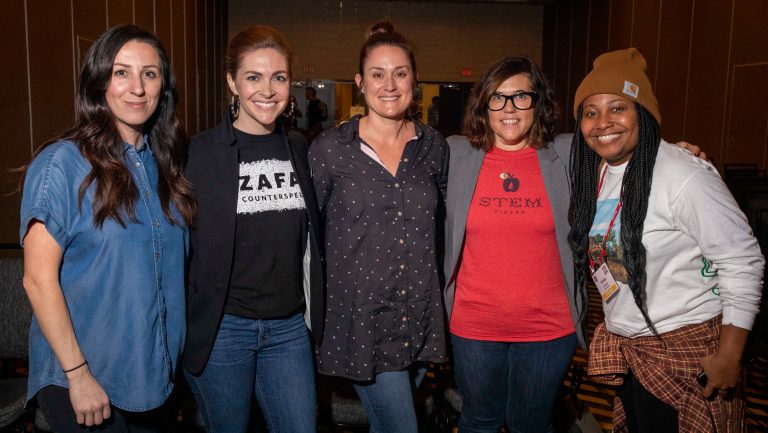For years, cider has been touted as “making a comeback” and “having a moment.” But one thing is now certain: Cider’s growth as a category is undeniable, and shouldn’t be ignored.
According to the U.S. Association of Cider Makers (USACM), cider sales grew to $1.3 billion in 2017, up 473 percent since 2011. The American cider industry, in particular, has grown exponentially. In 2011 there were 187 registered cideries. By 2014, that number had grown to 403. Today there are 820.
Yet several questions remain for cider, including, What’s the best way to sell it?

Don’t miss the latest drinks industry news and insights. Sign up for our award-winning newsletters and get insider intel, resources, and trends delivered to your inbox every week.
Much of cider’s earlier growth was driven by ciders that were more in line with craft beer, what the USACM would classify as “modern ciders,” which are made from dessert apples and typically sold on draft and in cans or 12-ounce bottles.
However, a burgeoning category, called heritage cider, represents ciders that are more winelike in style and as such are often packaged in 750-ml or 500-ml bottles. Orchard-based heritage ciders are noted for their increased complexity and expressive tannins and, according to the USACM’s style guide, are primarily made using traditional cider-specific bittersweet or bittersharp apples, older heirloom varieties, wild-foraged apples, or crab apples.
Heritage cider is forecast to be cider’s second wave of popularity—but bars and restaurants have been slow to figure out how to sell it to customers.
“The obstacles to getting the everyday consumer to appreciate the value of heritage cider in a 750-ml bottle are really difficult,” says Sam Fitz, a co-owner of ANXO Cidery & Tasting Room of Washington, D.C., and a member of the USACM board.

“It can be a hard sell,” says Aaron Kahn of Würstbar, a craft beer bar in Jersey City, New Jersey, that also offers an extensive cider menu, with upwards of 50 ciders, including more than 20 available in 500-ml and 750-ml bottles. “A customer’s going to pay $40 on a bottle, and they might not get it.” It’s important to note, though, that there are plenty of heritage ciders available for well under $40 a bottle—and certainly at a lower price than most bottles featured on restaurant wine lists.
Education, of course, is key. “If the staff doesn’t know what it is, it’s never going to get sold,” says Ambrosia Borowski, the general manager at The Northman, a cider pub in Chicago that features 22 draft ciders and around 150 ciders available in bottles and cans. As part of her commitment to cider education, Borowski sends out a weekly email to staff, offers educational sessions once a month, and allows individual staff members to brush up on ciders with managers on an as-needed basis. The Northman also offers a monthly Cider School program for customers, covering topics such as perry (made from pears), wood-aged ciders, seasonal apple picking, and apple brandy.
In 2016, in an effort to meet the growing need for education for cider professionals, the USACM launched the Certified Cider Professional (CCP) program, an online certification program similar to the cicerone program for the beer industry. The CCP program is targeted toward distributors, servers, and other beverage professionals interested in developing their cider knowledge and expertise.
Part of the program is dedicated to instruction on pairing food and cider in an effort to highlight how food friendly cider is, especially with pork and cheese. “If you have pork on your menu, you should absolutely have a heritage cider in the bottle,” says Michelle McGrath, the executive director of the USACM.

The Case for More Cider Bars
Cider bars have been popping up across the country, but many feel there are still far too few to help expand the category
As for how to move more cider bottles on the floor, offering it by the glass from a 750-ml bottle, as a wine bar does with wine, is an essential place to start. “I try to provide one approachable and one kind of funkier cider by the glass, and lean people into bottles from there,” says Eric Bigger, the general manager of Imperial, a restaurant in Portland, Oregon that offers cider only by the bottle. “It’s a gateway to get people in.”
And if you have multiple ciders available by the glass, you’re then able to offer flights. At Gramercy Tavern in New York City, beverage director Zach Siegel offers a flight of three ciders poured from 750-ml bottles, giving customers an opportunity to taste a range of ciders they might not already be familiar with. If customers discover a cider they like, they’re more likely to feel comfortable ordering a whole bottle.
By-the-glass pours aren’t a cure-all solution, though, and might not fit with every beverage program. At Würstbar, Kahn struggles to make glass pours work. “We’re a craft beer bar,” he says, “and one of my biggest challenges with bigger bottles is that we don’t pour them by the glass for cost and waste reasons.”
Instead, Kahn relies heavily on telling stories about the places where those bottles of cider come from, and the producers who make them. At Imperial in Portland, Bigger does the same. “When you have a story to tell about a cider, you can draw somebody in that way,” he says. “Just like with wine.”
If you don’t have the information you need about the ciders you carry—or want to carry—The Northman’s Borowski recommends that you reach out to the people who make it. “The cider community is always an open book,” she says. “Cider makers are always more than happy to help you.”
One of the driving factors behind cider’s growth was consumers’ increasing interest in gluten-free products. But cider is no longer just a gluten-free alternative to beer. Heritage cider checks all the right trendy-beverage boxes: It’s generally lower in alcohol, made by craft producers, and capable of expressing terroir. The next step forward is to make a place for it at the table—and not just from a draft line or can. “If you want to get on board with having premium products on your menu,” says McGrath, “then you really want to have cider available by the bottle.”

Dispatch
Sign up for our award-winning newsletter
Don’t miss the latest drinks industry news and insights—delivered to your inbox every week.
Shelby Vittek has written for Wine Enthusiast, Food & Wine, Bon Appétit, the Washington Post, Modern Farmer, National Geographic, Liquor.com, and Plate Magazine, among other publications. Follow her on Twitter and Instagram: @bigboldreds.







